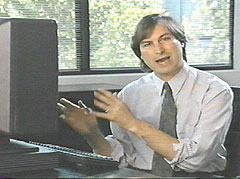Founded in 1993 by Steve Jobs
Headquarters: Redwood City, California
Purchased by Apple in 1997

NeXT
|
Founded in 1993 by Steve Jobs |

|

From the Museum Collection |
After recruiting five other Apple employees, he announced plans to create a new company, appropriately called NeXT, that would create computers and software catering specifically to colleges and universities.
His mission took him longer than imagined. He also had to rely on big-time investors like Ross Perot to keep the company afloat while he developed a brand-new operating system, a variation of Unix, that would make writing software and applications easier and take away monopolization by the big boys of the computing world. In October 1988, Jobs debuted the NeXT Cube that was most certainly an innovation in look and design. At $6,500, $3,000 above what Jobs originally hoped for a retail price, it was indeed fast with advanced sound technology and a higher capacity erasable optical disk drive (cousins of the CD-ROM and a hoped-for replacement for traditional magnetic disk drives).

From the Museum Collection |
Jobs kept trying to refine his original concept for NeXT computers, but in 1993 finally pulled the plug on the hardware division. He then threw his energy into the operating system he had created for his computers, believing it would completely change the way software was made and created, leaving his competitors out of the loop.

From the Museum Collection |
While alternatively trying to bolster his NeXT software company, Jobs accidently happened upon a boon to his business through Pixar, an animation studio he purchased in 1986 when he bought out a computer division of Lucusfilms Ltd. for $60 million. Pixar went on to create the fully computer-generated feature, "Toy Story," in 1996 and when Pixar went public that year, Jobs became a billionaire virtually overnight.
Then Apple came courting. The company announced in December of 1996 that it would buy NeXT for $430 million and hire Jobs on as an "advisor." A year later, Jobs was re-installed as CEO of the company he helped created.

|
|
Close this window to return to the Computer Museum of America.